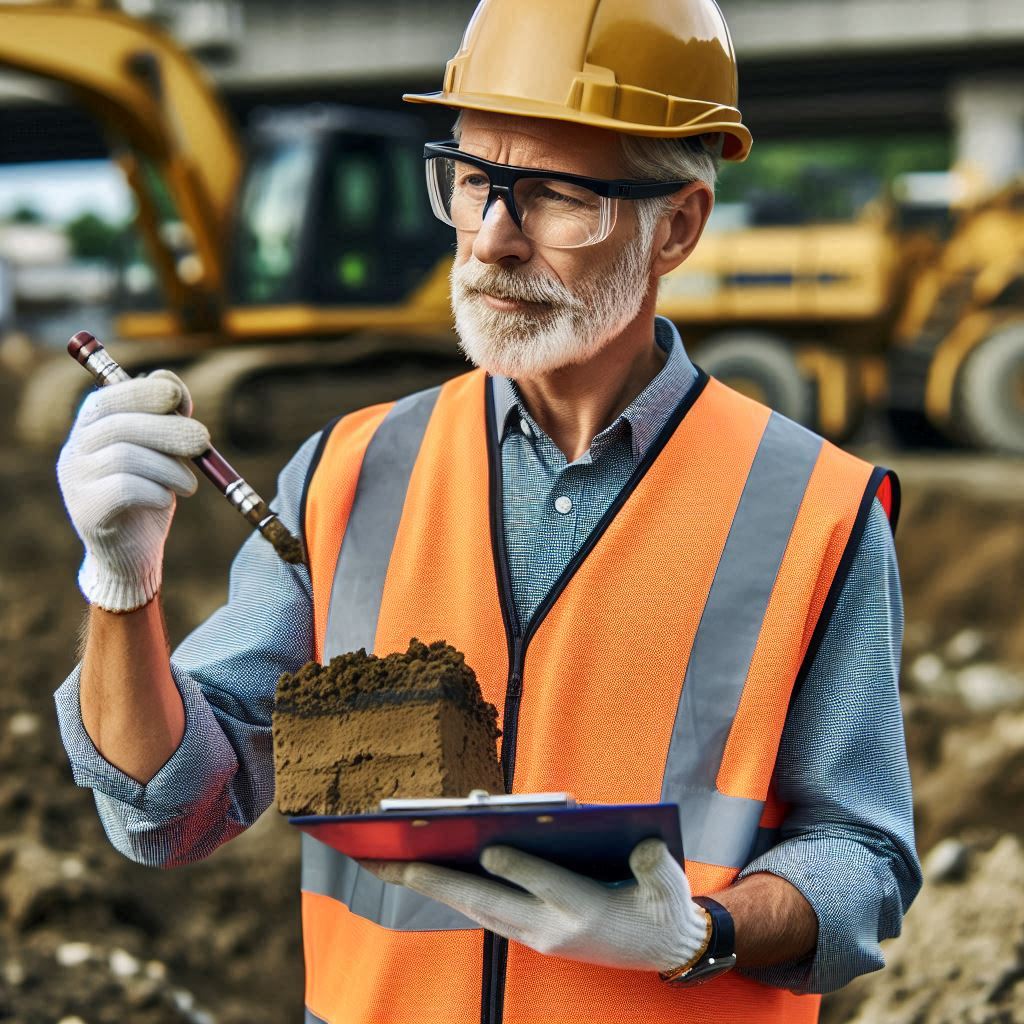Introduction
Geotechnical engineering focuses on analyzing soil and rock properties to design safe and efficient foundations and earth structures.
It plays a critical role in sustainable development by ensuring that construction projects are both structurally sound and environmentally responsible.
Incorporating geotechnical engineering practices helps minimize environmental impacts and promotes the conservation of natural resources.
These practices include assessing soil stability, preventing erosion, and managing groundwater resources to ensure sustainable land use.
Proper soil analysis is crucial for designing structures that reduce land degradation and protect ecosystems.
For instance, geotechnical engineers develop erosion control measures that prevent sediment from polluting waterways and damaging habitats.
Additionally, managing groundwater effectively prevents over-extraction and contamination, ensuring that water resources remain available and clean for future use.
Sustainable geotechnical solutions also support renewable energy projects like wind farms and solar installations, which rely on stable foundations and minimal environmental disruption.
By prioritizing eco-friendly methods, geotechnical engineers help ensure that development projects do not compromise the environment.
Implementing these practices maintains ecological balance and supports long-term environmental health, demonstrating the essential role of geotechnical engineering in sustainable development.
Definition and Scope of Geotechnical Engineering
Geotechnical engineering is a branch of civil engineering that focuses on the behavior of earth materials.
It involves analyzing soil, rock, groundwater, and their interaction with structures.
This field ensures that construction projects are built on solid, stable ground.
By studying the properties and mechanics of soil and rock, geotechnical engineers can predict how these materials will behave under different conditions.
The scope of geotechnical engineering in construction projects is extensive.
It covers site investigation, foundation design, and slope stability analysis.
Geotechnical engineers conduct soil tests to determine the best foundation type for a structure.
They design retaining walls to prevent landslides and manage groundwater to avoid flooding.
Their work is essential in building safe, durable structures.
Definition of Geotechnical Engineering
Geotechnical engineers play a crucial role in ensuring sustainable development practices.
They help minimize environmental impact by selecting appropriate construction techniques.
Sustainable development requires balancing economic growth, environmental protection, and social well-being.
Geotechnical engineers contribute by designing projects that use resources efficiently and reduce waste.
In sustainable construction, geotechnical engineers assess and mitigate environmental risks.
They evaluate potential hazards such as soil erosion and groundwater contamination.
By addressing these issues early, they prevent long-term environmental damage.
This proactive approach helps preserve natural resources for future generations.
Scope of Geotechnical Engineering in Construction Projects
- Site Investigation: Conducting detailed assessments of soil, rock, and groundwater conditions to inform design and construction.
- Soil Testing: Performing laboratory and field tests to determine soil properties such as strength, compressibility, and permeability.
- Foundation Design: Designing foundations that are appropriate for the soil conditions and structural requirements, including shallow and deep foundations.
- Slope Stability Analysis: Evaluating and designing measures to prevent landslides and ensure the stability of slopes and embankments.
- Retaining Wall Design: Designing retaining structures to support soil and prevent erosion or collapse.
- Groundwater Management: Developing systems to control and manage groundwater levels to prevent flooding and ensure stability.
Role of Geotechnical Engineers in Ensuring Sustainable Development Practices
- Soil and Rock Analysis: Conduct detailed assessments to determine soil and rock properties, ensuring stable and safe construction foundations.
- Design of Sustainable Foundations: Create designs that minimize land disturbance and resource consumption, supporting long-term structural stability.
- Erosion Control: Implement measures to prevent soil erosion and sediment runoff, protecting water bodies and ecosystems.
- Groundwater Management: Monitor and manage groundwater resources to prevent over-extraction and contamination, ensuring sustainable water availability.
- Waste Management: Develop strategies for managing construction waste and by-products, reducing environmental impact and promoting recycling.
- Site Remediation: Address and remediate contaminated sites, restoring environmental health and reducing hazards.
- Support for Renewable Energy Projects: Design stable foundations for renewable energy installations like wind turbines and solar panels, minimizing environmental disruption.
- Risk Assessment and Mitigation: Identify and mitigate potential geotechnical risks, reducing the likelihood of environmental damage due to construction activities.
Read: Graduate Studies in Biomedical Engineering
Geotechnical Engineering and Natural Hazards
Impact of natural hazards on infrastructure
- Soil and Rock Analysis: Conduct detailed assessments to determine soil and rock properties, ensuring stable and safe construction foundations.
- Design of Sustainable Foundations: Create designs that minimize land disturbance and resource consumption, supporting long-term structural stability.
- Erosion Control: Implement measures to prevent soil erosion and sediment runoff, protecting water bodies and ecosystems.
- Groundwater Management: Monitor and manage groundwater resources to prevent over-extraction and contamination, ensuring sustainable water availability.
- Waste Management: Develop strategies for managing construction waste and by-products, reducing environmental impact and promoting recycling.
- Site Remediation: Address and remediate contaminated sites, restoring environmental health and reducing hazards.
- Support for Renewable Energy Projects: Design stable foundations for renewable energy installations like wind turbines and solar panels, minimizing environmental disruption.
- Risk Assessment and Mitigation: Identify and mitigate potential geotechnical risks, reducing the likelihood of environmental damage due to construction activities.
Read: Biomedical Engineering: Impact on Public Health
Sustainable Construction Practices in Geotechnical Engineering
Use of Recycled Materials in Geotechnical Projects
Sustainable construction practices in geotechnical engineering increasingly emphasize the use of recycled materials to mitigate environmental impact.
By integrating recycled aggregates such as crushed concrete and recycled asphalt into foundation and embankment designs, engineers effectively reduce the consumption of virgin materials.
This approach not only conserves natural resources but also minimizes the carbon footprint associated with material production and transportation.
Utilizing recycled materials helps divert waste from landfills and supports a circular economy, reinforcing the commitment to sustainable development within the industry.
Energy-Efficient Techniques in Construction
Energy-efficient techniques are crucial for enhancing sustainability in geotechnical engineering.
Engineers focus on optimizing soil and rock stabilization processes to reduce energy consumption throughout construction.
For example, using energy-efficient machinery for soil compaction and adopting low-energy grouting methods helps decrease the overall energy required for project execution.
By implementing these energy-saving practices, engineers lower the environmental impact of their projects and contribute to reducing greenhouse gas emissions.
This focus on energy efficiency supports the broader goal of minimizing the ecological footprint of construction activities.
Implementation of Green Building Practices for Sustainable Development
Implementing green building practices is essential for achieving sustainable development goals.
Geotechnical engineers incorporate eco-friendly materials and construction methods that emphasize minimal environmental disruption.
Techniques such as low-impact construction reduce land disturbance and preserve natural habitats, aligning with conservation efforts.
Additionally, engineers integrate energy-efficient systems, including geothermal heating and cooling, into building foundations to reduce long-term energy demands.
These systems enhance the overall sustainability of structures by lowering operational energy use and promoting environmental stewardship.
Integrating recycled materials, energy-efficient techniques, and green building practices into geotechnical engineering projects plays a pivotal role in advancing sustainable development.
By focusing on these practices, engineers create structures that are not only durable and functional but also environmentally responsible.
These efforts contribute to maintaining ecological balance, conserving resources, and promoting long-term sustainability in the construction industry.
Embracing these sustainable practices ensures that development projects align with broader environmental goals and support a more sustainable future.
Read: Biomedical Engineering: Industry Outlook 2024

Geotechnical Engineering for Soil Stabilization
Importance of soil stabilization in construction projects
- Ensures structural stability and safety
- Prevents soil settlement and shifting
- Enhances load-bearing capacity of foundations
- Reduces risks of structural failures
- Improves soil compaction and density
- Facilitates construction on weak or unstable soils
- Supports long-term durability of infrastructure
- Minimizes the need for extensive excavation
- Helps in managing groundwater and reducing erosion
Techniques Used for Soil Stabilization
- Soil Replacement
- Deep Soil Mixing
- Geotextiles and Geogrids
- Lime Stabilization
- Cement Stabilization
- Fly Ash Stabilization
- Bituminous Stabilization
- Electrokinetic Stabilization
- Biotechnical Methods (e.g., vegetation)
- Soil Cement
- Microbial Soil Stabilization
- Dynamic Compaction
Benefits of Soil Stabilization in Promoting Sustainable Development.
- Reduces Soil Erosion: Prevents loss of topsoil and degradation of land.
- Enhances Soil Strength: Improves load-bearing capacity and structural stability.
- Lowers Construction Costs: Minimizes the need for extensive excavation and fill materials.
- Decreases Environmental Impact: Reduces the use of virgin materials and minimizes waste.
- Improves Water Management: Enhances soil‘s ability to manage stormwater and reduce runoff.
- Increases Durability: Extends the lifespan of infrastructure and reduces maintenance needs.
Geotechnical Engineering for Water Management
Geotechnical engineers evaluate soil characteristics to determine water flow and storage capacity.
Designing foundations, retaining walls, and dams require a thorough understanding of soil-water interactions.
Geotechnical investigations help in selecting appropriate construction materials for water infrastructure projects.
Monitoring and maintenance of drainage systems are necessary to prevent soil erosion and water pollution.
Geosynthetics like geotextiles and geomembranes are used in water management structures for reinforcement and sealing.
Role of Geotechnical Engineering in Water Resource Management
Geotechnical engineering significantly impacts water resource management by analyzing and managing soil and groundwater conditions that influence water availability, quality, and distribution.
Engineers in this field evaluate soil properties, including permeability, compaction, and stability, which are critical for designing structures that interact with groundwater.
For instance, proper assessment of soil characteristics ensures that foundations are adequately supported, reducing the risk of structural failure due to groundwater fluctuations.
Additionally, geotechnical engineers develop solutions to prevent and manage soil erosion, which can affect water quality and availability.
Techniques for Groundwater Recharge Using Geotechnical Methods
Groundwater recharge techniques utilizing geotechnical methods are vital for replenishing aquifers and maintaining sustainable water supplies.
One effective technique is the construction of recharge wells, which allow surface water to infiltrate directly into the groundwater table through specially designed boreholes.
This method is particularly useful in areas where natural recharge is insufficient.
Infiltration basins, another geotechnical method, are designed to collect and slowly release surface water into the ground.
These basins can be engineered to manage stormwater runoff and enhance natural groundwater replenishment by increasing the amount of water that percolates into the soil.
Pervious pavements are also an innovative technique, allowing rainwater to pass through surfaces and infiltrate into the ground, thereby reducing runoff and promoting groundwater recharge.
These techniques not only support groundwater replenishment but also help in managing stormwater and mitigating flood risks.
Importance of Sustainable Water Management Practices in Geotechnical Projects
Sustainable water management practices are crucial in geotechnical projects to minimize environmental impact and ensure the long-term availability and quality of water resources.
Implementing these practices involves integrating methods that enhance groundwater recharge, prevent soil and water contamination, and optimize the use of water resources.
For example, incorporating recharge wells, infiltration basins, and pervious pavements into project designs can effectively manage and replenish groundwater supplies.
Furthermore, sustainable practices involve careful site selection and planning to avoid disrupting natural water flows and ecosystems.
By adopting these methods, geotechnical engineers contribute to reducing the ecological footprint of construction projects, enhancing the resilience of infrastructure to water-related issues, and supporting the broader goals of environmental sustainability.
Ensuring that water management practices are aligned with sustainable development principles helps protect water resources for future generations while maintaining the integrity and functionality of geotechnical projects.
Read: Exploring Subfields of Aerospace Engineering
Case Studies in Geotechnical Engineering and Sustainable Development
Examples of Successful Geotechnical Projects Promoting Sustainable Development
Several successful geotechnical projects highlight how engineering can support sustainable development.
The Oresund Bridge, connecting Denmark and Sweden, exemplifies innovative geotechnical solutions.
Engineers faced challenging soil conditions and high groundwater levels.
They employed advanced techniques like soil grouting and deep foundation systems to ensure stability while minimizing environmental disruption.
This project not only enhanced regional connectivity but also integrated sustainable practices, such as reducing construction waste and using eco-friendly materials.
Similarly, the Marina Bay Sands in Singapore stands as a testament to effective geotechnical engineering in a dense urban environment.
The project required extensive soil stabilization and foundation work due to the site‘s challenging conditions.
Engineers used advanced techniques like pile foundations and ground improvement methods to support the massive structure.
Additionally, Marina Bay Sands incorporated green building practices, including energy-efficient systems and water conservation measures, promoting sustainable development in a high-profile urban setting.
Impact of Geotechnical Engineering on Environmental Conservation
Geotechnical engineering plays a pivotal role in environmental conservation by developing infrastructure that minimizes ecological impact.
Techniques such as soil stabilization, erosion control, and the use of geosynthetics help manage and mitigate environmental risks.
For instance, soil stabilization methods prevent erosion and sediment runoff, protecting water bodies and natural habitats from contamination.
The installation of geosynthetics in construction projects can reduce the need for more invasive techniques, thereby preserving surrounding ecosystems.
Moreover, geotechnical engineers are involved in remediation projects that rehabilitate contaminated sites, restoring them to a natural state.
For example, engineers use soil washing and bioremediation techniques to remove pollutants from contaminated land.
These efforts contribute to environmental conservation by cleaning up polluted areas and enabling their return to productive use.
By integrating sustainable practices and focusing on minimizing environmental impact, geotechnical engineering supports broader conservation goals and promotes healthier ecosystems.
Transform Your Career Today
Unlock a personalized career strategy that drives real results. Get tailored advice and a roadmap designed just for you.
Start NowLessons Learned from Past Projects for Future Sustainable Development Initiatives
Analyzing past geotechnical projects provides valuable insights for future sustainable development.
One critical lesson is the need to incorporate environmental considerations early in the design and planning stages.
For example, projects like the Oresund Bridge and Marina Bay Sands demonstrated that understanding and addressing site-specific environmental conditions can lead to more sustainable outcomes.
Early integration of environmental assessments and innovative engineering solutions helps mitigate potential impacts and reduces the overall environmental footprint.
Another important lesson is the value of using sustainable materials and construction techniques.
Past projects have shown that employing eco-friendly materials and energy-efficient systems can significantly reduce environmental impact.
Engineers should consider options like recycled materials and green technologies to enhance sustainability.
Furthermore, thorough site investigations and continuous monitoring are essential for effective hazard management and environmental protection.
Learning from previous successes and challenges enables engineers to develop more effective strategies for sustainable development, ensuring that future projects contribute positively to both infrastructure and environmental conservation.
Uncover the Details: Balancing Work and Life as a Database Administrator
Future Trends in Geotechnical Engineering for Sustainable Development
Advancements in Geotechnical Engineering Technologies
Advancements in geotechnical engineering technologies have significantly transformed the field, improving both accuracy and efficiency.
Modern techniques such as 3D geotechnical modeling allow engineers to create detailed, three-dimensional representations of subsurface conditions.
This enhances the precision of site assessments and reduces uncertainties in design.
Advanced geophysical surveys, including ground-penetrating radar and seismic reflection methods, provide high-resolution data on soil and rock properties.
Innovations in instrumentation and monitoring, such as automated data acquisition systems and remote sensors, facilitate real-time analysis of ground conditions and structural performance.
These technologies enable early detection of potential issues, allowing for timely interventions and more informed decision-making.
The integration of machine learning and artificial intelligence into geotechnical analysis further refines predictive models and optimizes design parameters, leading to more reliable and efficient engineering solutions.
Integration of Geotechnical Engineering with Smart Infrastructure Development
The integration of geotechnical engineering with smart infrastructure development represents a significant advancement in creating intelligent and resilient urban environments.
Smart infrastructure projects incorporate advanced sensors and data analytics to monitor structural health and ground conditions continuously.
These systems collect and analyze real-time data on factors such as soil movement, groundwater levels, and structural loads.
By leveraging this data, engineers can optimize infrastructure performance, predict maintenance needs, and enhance safety.
Smart geotechnical systems also enable dynamic responses to changing conditions, such as adjusting foundation support or managing groundwater flows.
This integration supports the development of intelligent cities that are more adaptive, efficient, and capable of withstanding environmental and operational stresses.
The use of real-time monitoring and predictive analytics ensures that infrastructure remains safe and functional throughout its lifespan.
Challenges and Opportunities for Sustainable Geotechnical Engineering Practices
Sustainable geotechnical engineering practices face both challenges and opportunities as the field evolves.
One major challenge is balancing the use of resources with the need to minimize environmental impact.
Techniques such as soil stabilization and foundation construction often involve significant material and energy consumption.
However, there are opportunities to address these challenges through the adoption of eco-friendly materials and innovative practices.
For example, using recycled aggregates and sustainable soil stabilization methods can reduce the environmental footprint of construction activities.
Additionally, advancements in green technologies, such as biotechnical methods that use vegetation for slope stabilization, offer sustainable alternatives.
Implementing effective waste management strategies and optimizing resource use further contribute to sustainability.
Embracing these opportunities not only supports responsible development but also enhances the long-term environmental stewardship of geotechnical engineering.
By integrating sustainable practices, the industry can contribute to a more balanced and eco-conscious approach to infrastructure development.
Conclusion
Geotechnical engineering plays a pivotal role in sustainable development by ensuring that construction projects are safe, stable, and environmentally responsible.
Accurate site investigations, innovative foundation designs, and effective soil stabilization techniques are essential for building resilient infrastructure while minimizing environmental impact.
By integrating advanced technologies and sustainable practices, geotechnical engineers can significantly enhance the efficiency and sustainability of construction projects.
It is crucial for the industry to embrace sustainable practices in every aspect of geotechnical engineering.
This includes adopting eco-friendly materials, optimizing resource use, and incorporating renewable energy solutions.
Engineers should strive to reduce waste, lower carbon footprints, and implement green technologies to align with global sustainability goals.
Collaboration between geotechnical engineers and environmental experts is key to achieving a sustainable future.
Working together, these professionals can develop comprehensive strategies that address both engineering and environmental considerations.
This interdisciplinary approach ensures that projects not only meet structural and safety requirements but also contribute positively to environmental conservation and community well-being.




